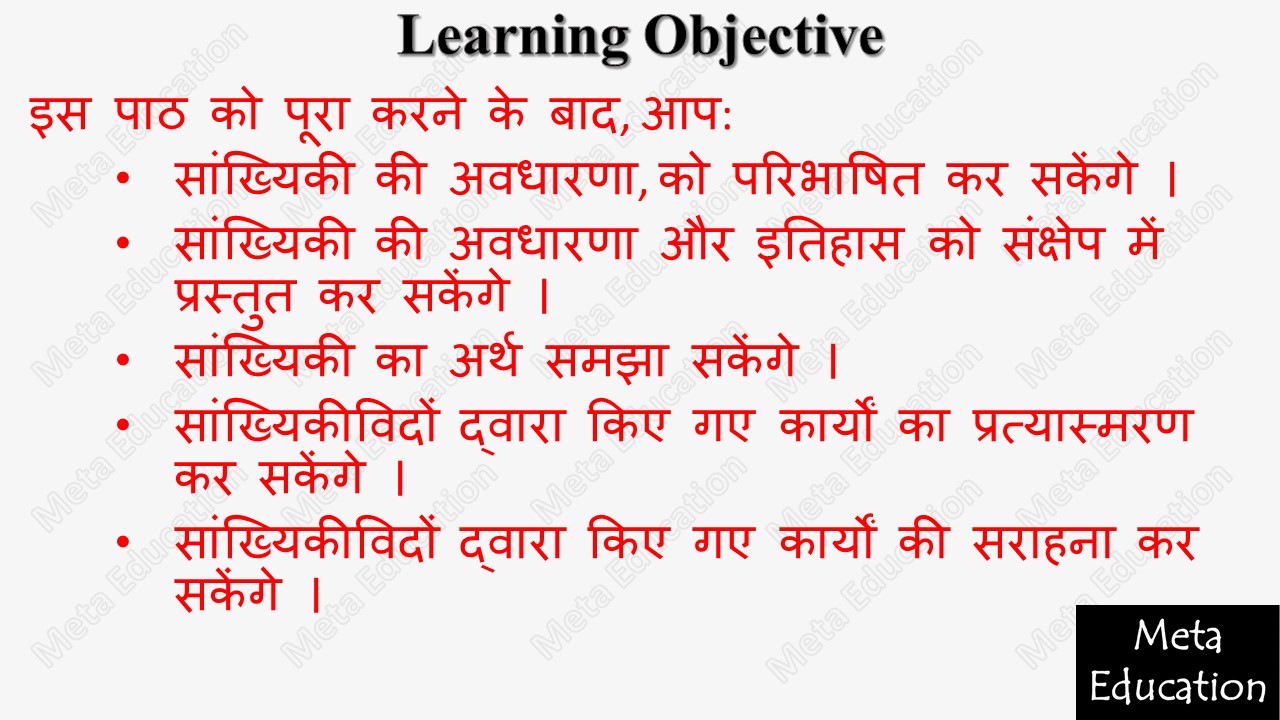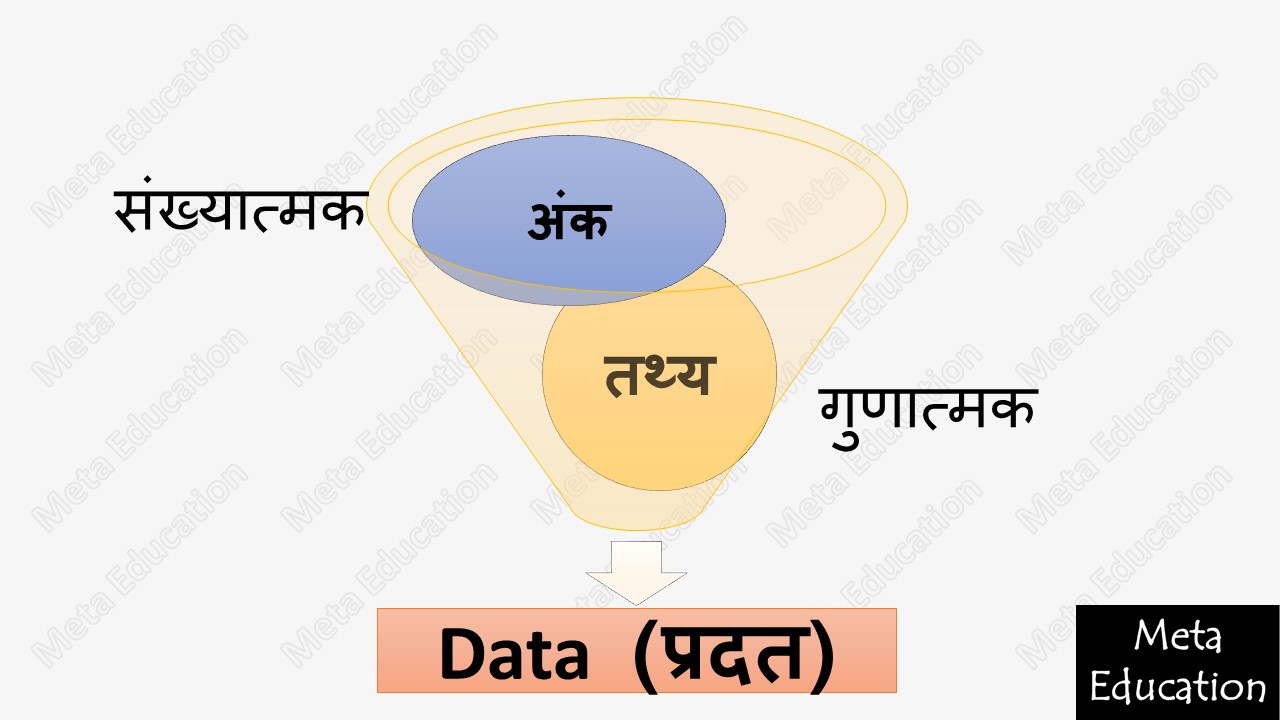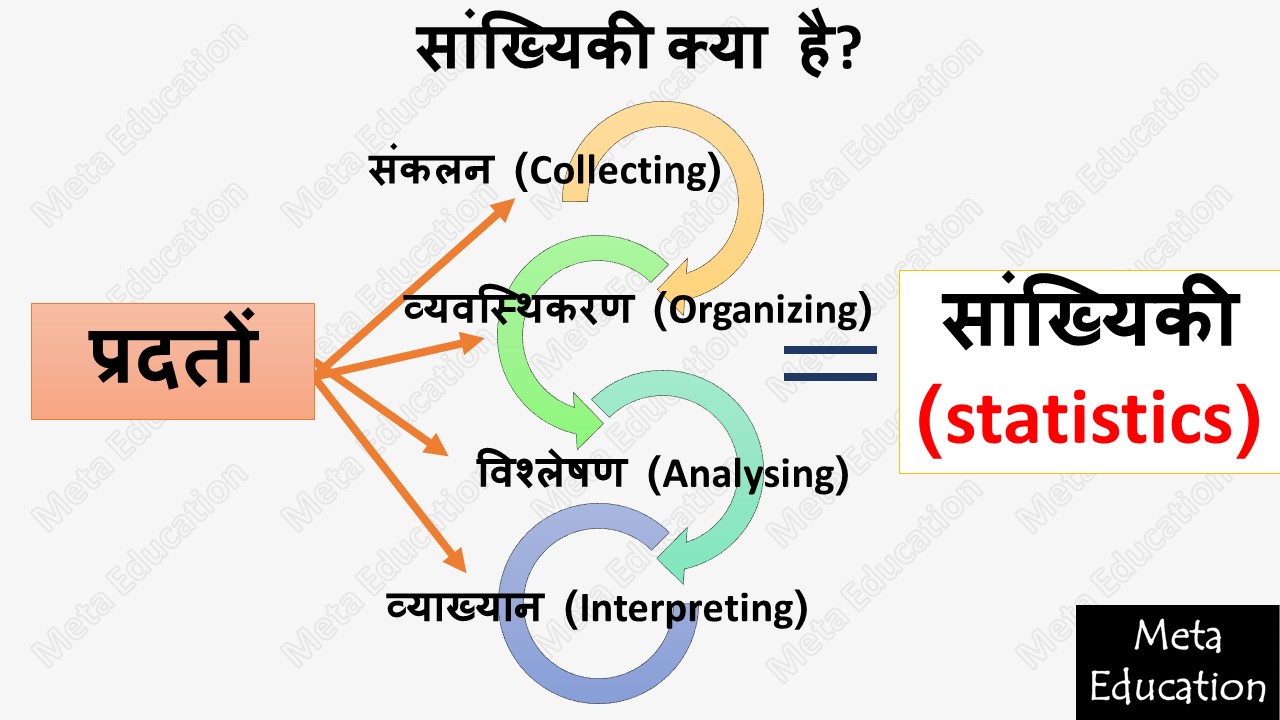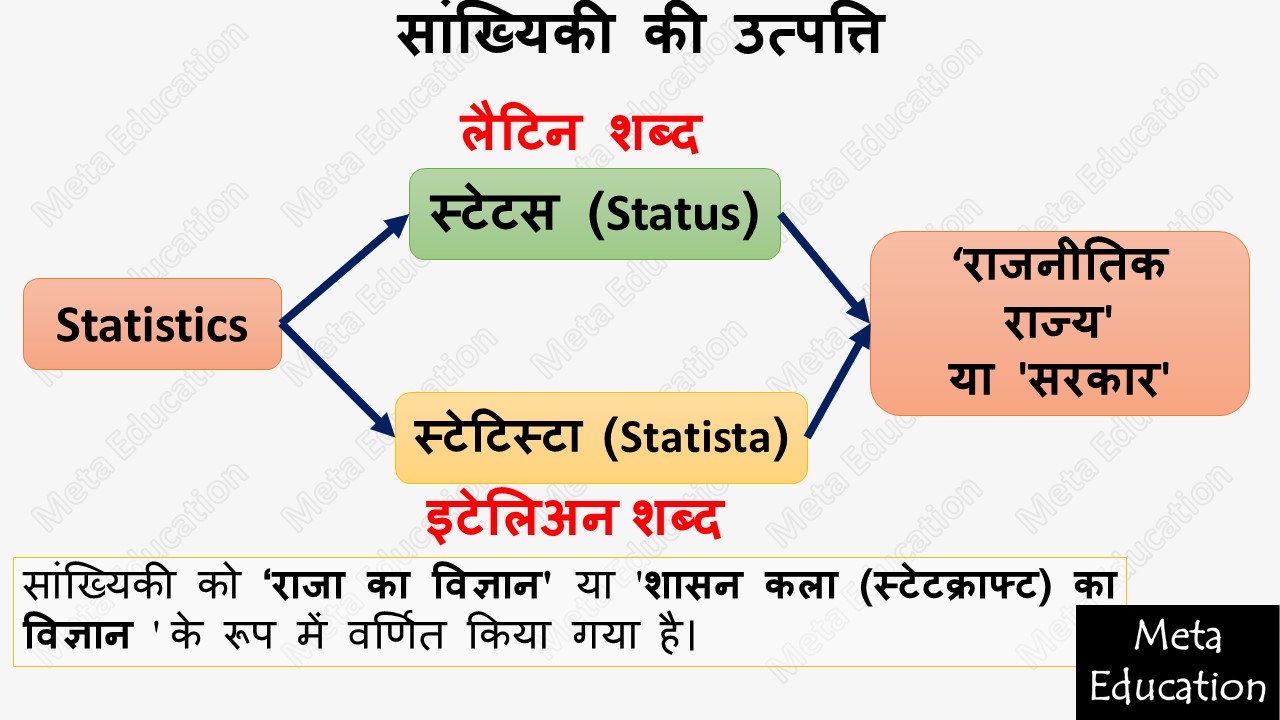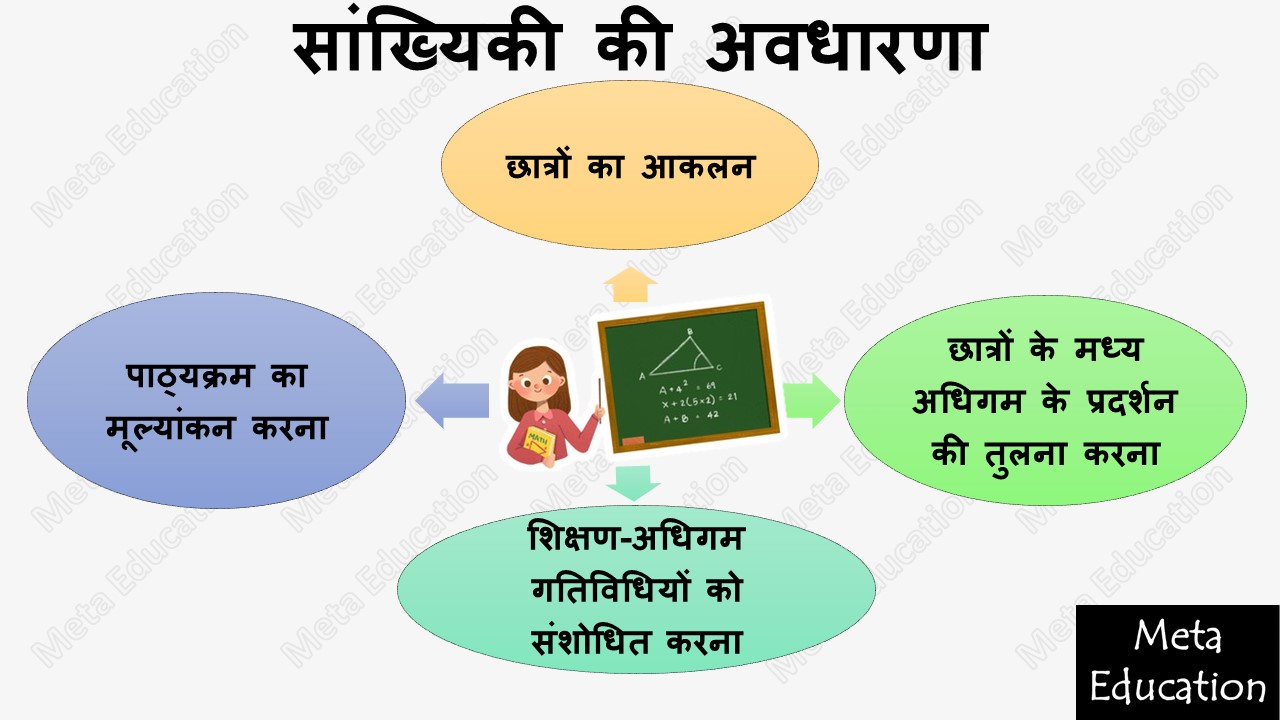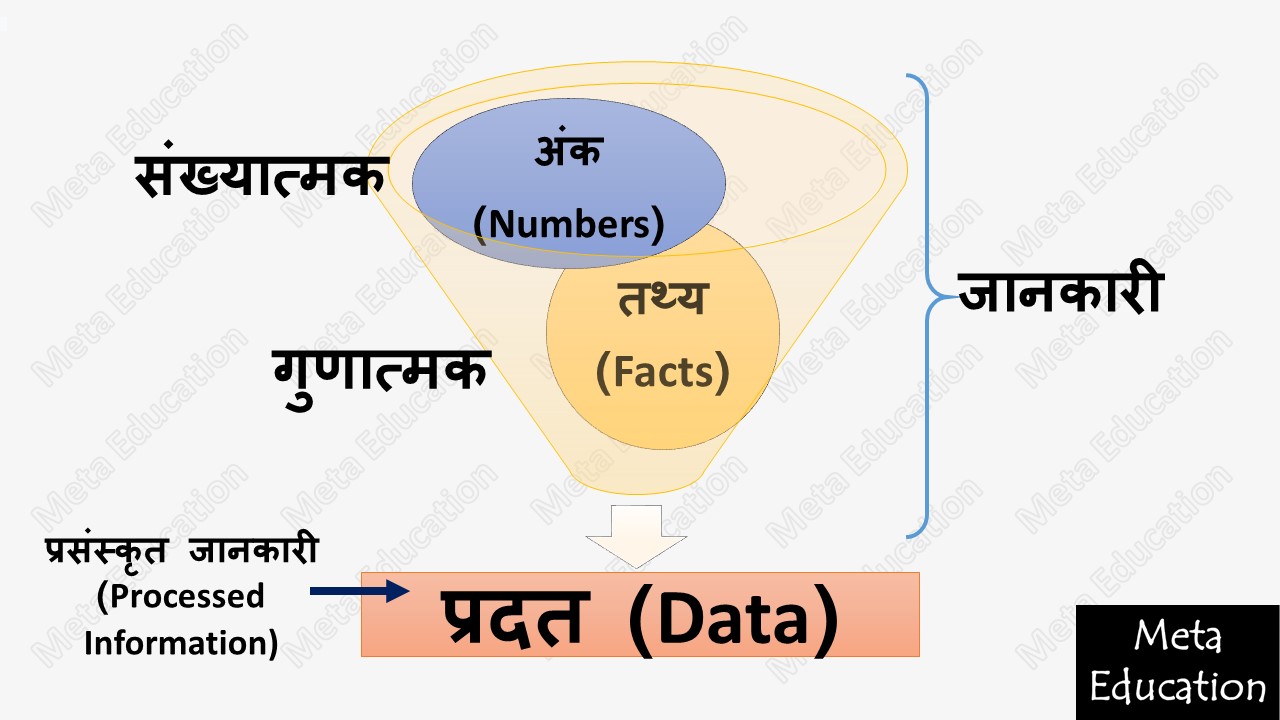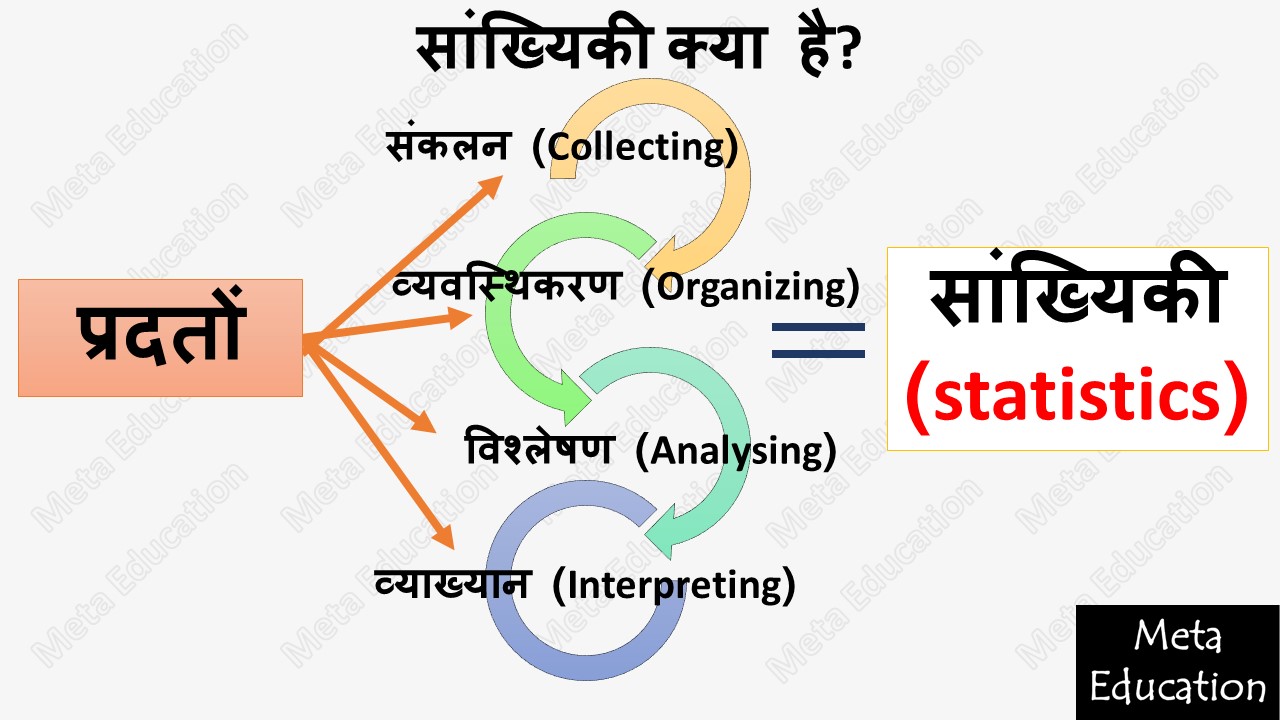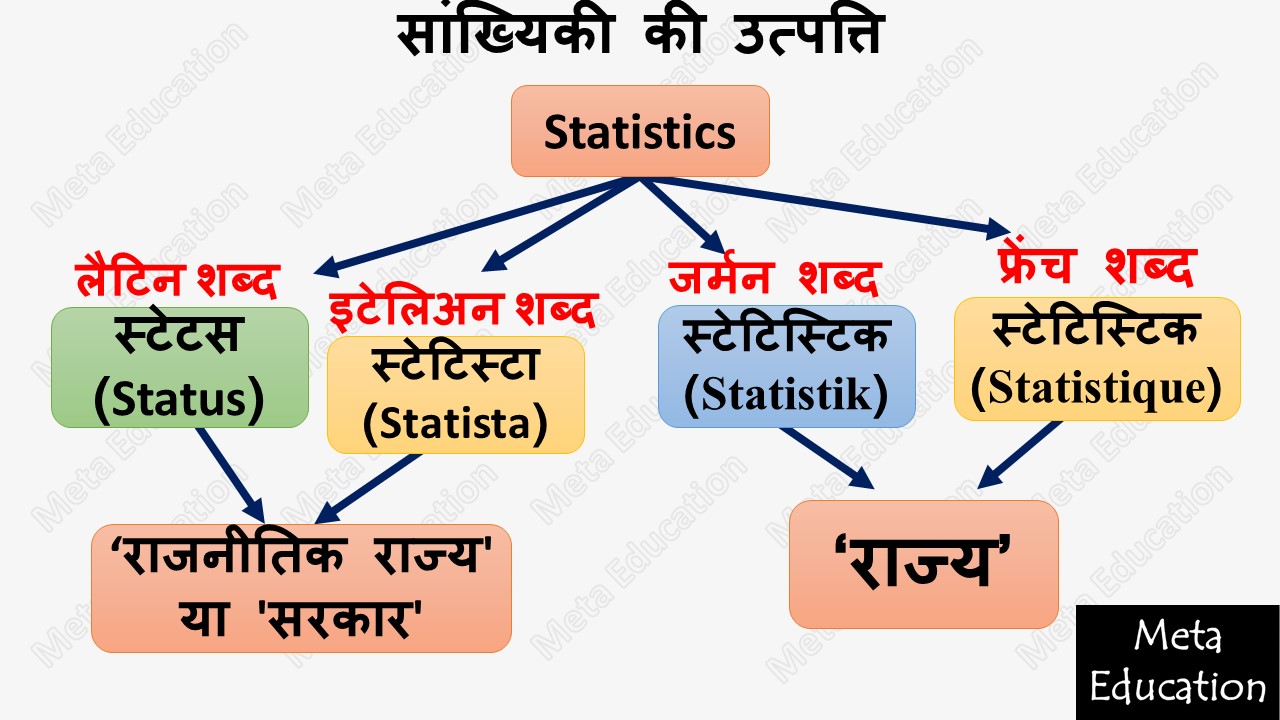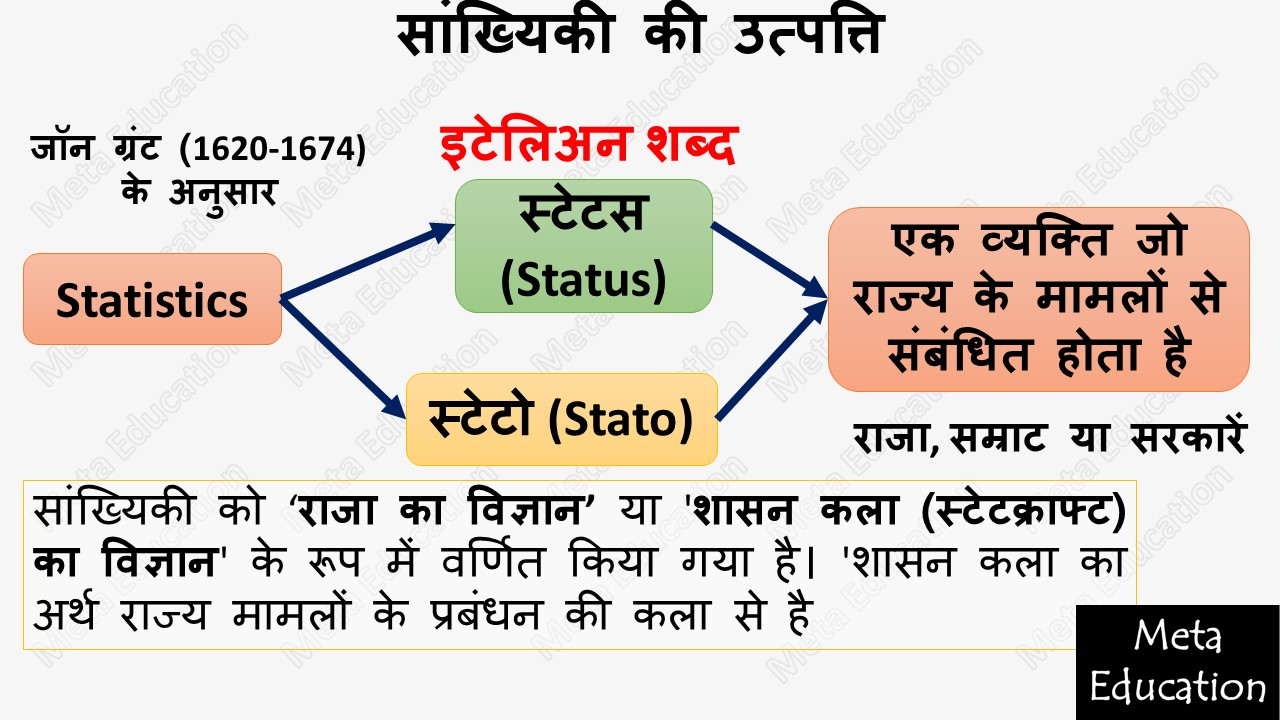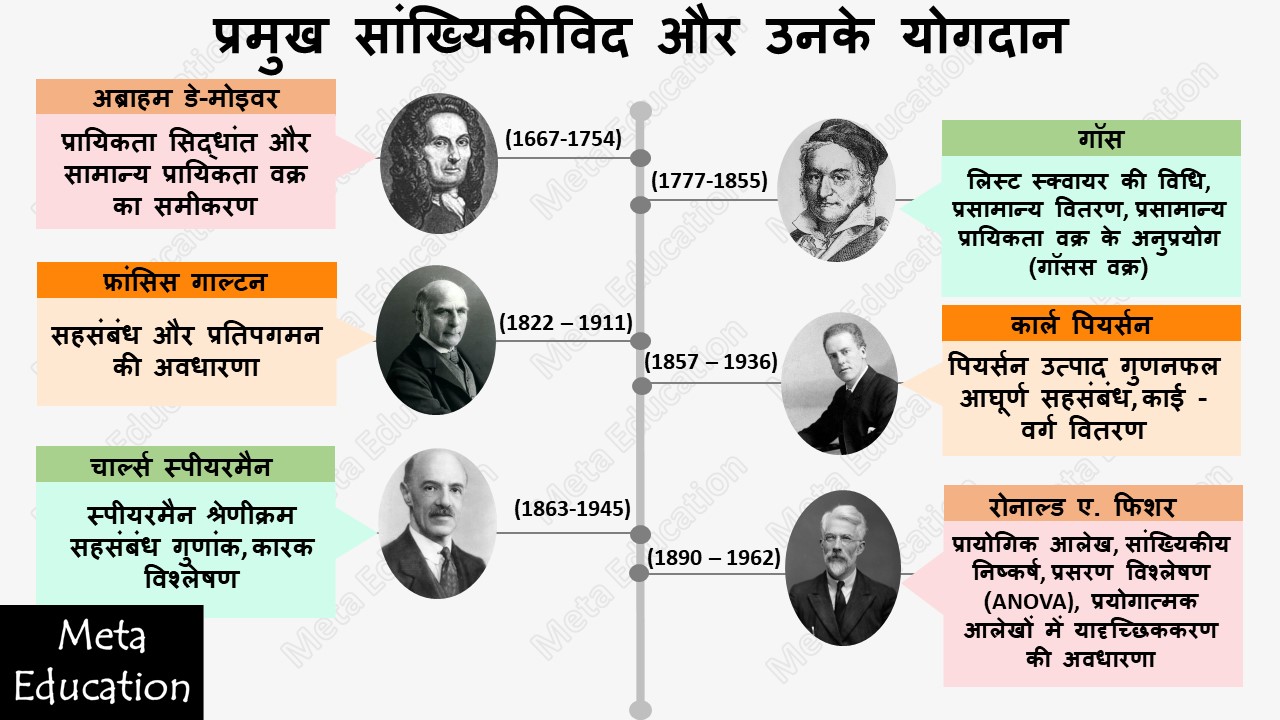Learning Objectives:
After completing this lesson, you will be able to:
- explain the concept of statistics.
- summarize the concept and history of statistics.
- explain the meaning of statistics.
- recognize the work done by statisticians.
- appreciate the contribution of statisticians.
अधिगम उद्देश्य:
इस पाठ को पूरा करने के बाद, आप:
- सांख्यिकी की अवधारणा को समझा सकेंगे ।
- सांख्यिकी की अवधारणा और इतिहास को संक्षेप में प्रस्तुत कर सकेंगे ।
- सांख्यिकी का अर्थ समझा सकेंगे ।
- सांख्यिकीविदों द्वारा किए गए कार्यों का प्रत्यास्मरण कर सकेंगे ।
- सांख्यिकीविदों द्वारा किए गए कार्यों की सराहना कर सकेंगे ।
English Audio transcript
Hello, this is Shalini.
Today we will learn about concept origin and history of statistics.
This is the lesson one of unit (a) of statistics applicable in assessment for learning.
After completing this lesson, you will be able to explain the concept of statistics,
summarize the concept and history of statistics, explain the meaning of statistics,
recognize the work done by statisticians, and appreciate the contribution of statisticians.
Concept of statistics.
In day to day life or teacher has to deal with many kinds of data,
in assessing students, in comparing the learning performance among the students,
in modifying teaching learning activities, and in evaluating curriculum,
a teacher has to go through with different kinds of data.
To carry out all these activities, varied types of data need to be collected,
generally, we collect data in two forms or we can say we collect information in two forms,
one is numeric and second is non numeric that is facts.
So, this is not data, this is just information, but when we process this information, this become data. Now see, what is statistics.
So, the process of collecting organizing, analyzing and interpreting data is known as statistics.
Whenever we process any type of data, whenever we collect any type of data,
whenever we analyzed any type of data or we interpreted it in any form, it is known as statistics.
Now see, what is the origin of statistics?
It is originated from two fields one is game of chance, and second political field,
game of chance is concerned with the concept of chance or probability,
this field is basically related to the gamblers So, we can say that statistics is originated from the gamblers
and the other fields that is political field is concerned with collection of state related data,
in political field or in in political area, the stakeholders of politics has to deal with many kinds of data
or they have to collect different kinds of data, they have to do some analysis on the data.
So, they get some meaningful conclusion out of that.
So, in that sense, we can say that statistics is originated from political field.
So, there are main two fields first is game of chance and second is political field.
If we talk about the word statistics, statistics word is originated from a Latin word
that is a status some says it originated from Italian word that is a statista
both have the same meaning, that is political state or government.
some other thoughts are also present regarding the origin of a statistics word
one is, it is originated from German word that is a statistik and
another thought regarding origin is, it is originated from a French word that is statistique
here the pronunciation is quite similar, but the spelling is different.
The meaning of both is state so in conclusion, we can say that all four words either Latin, Italian, German, or French has different origin word but the meaning is same.
According to john Grant (1622-1674), the word statistic is originated from Italian word status.
And another Italian word is stato.
here the meaning is quite different from the previous ones status and status is known as a person who deals with affairs of the state
he or she can be a king or monarch or government.
So in this sense, statistics is described as the science of King or the science of statecraft.
Here the meaning of statecraft is the art of managing state of affairs, how a king or monarch or government is efficient in managing state of affairs
impacts their power to deal with different kinds of problems and affairs related to state I hope the origin of statistics is clear to you now.
Now, lets see, prominent statisticians and their contribution in the field of statistics.
So, first is Abraham De-Moreover, he has given the theory of probability an equation of normal probability curve that is called NPC.His time period is 1667 to 1754.
After him, another statistical is Gauss (1777 to 1855). He gave the method of least square, normal distribution and application of NPC.
Next is Francis Galton (1822 to 1911). He gave the concept of correlation And Regressionthese are very meaningful and helpful concepts in the field of statistics.
1857 to 1936, Karl Pearson, he gave the concept of Pearson product moment correlation and chi square distribution.
Next is Charles Spearsman 1863 to 1945 he gave the concept of Spearsmen rank correlation coefficient and factor analysis.
Next is 1890 to 1962 Ronald A. Fisher, he gave the concept of experimental design, ANOVA, concept of randomization in experimental design.
I hope now you get short introduction about statistics and some information about statisticians and their contributions.
If you have any kind of doubt, you can ask us by comment in the comment box.
Thank you and have a nice day.
1.1 Concept of Statistics
In day-to-day life, a teacher deals with different kinds of
data. Apart from assessing the students, data serve many purposes such as
comparing the learning performance among students, modifying teaching-learning
activities, evaluating curriculum, and so on. To carry out these activities,
varied types of data need to be collected. Generally, data are collected in the
form of numbers or non-numeric forms. In this process, data are first obtained
and then interpreted to make decisions. The process of collecting, organizing,
interpreting, and analyzing the data is termed “statistics”. For converting raw
data into some meaningful information, we need to apply Statistics. Statistics
enables us to study raw scores objectively. It makes the teaching-learning
process more efficient.
1.2 Origin of Statistics
Statistics is not a new discipline but it is as old as
human society itself. This is because most of the decisions taken by a human
being are based on past experiences he/she has experienced actually, which are
directly or indirectly based on statistical data and future events are also
predicted by using or examining the past behaviour of that particular event.
Statistics has originated from two different fields. They are games of
chance and political fields. You may note that the former i.e. games
of chance is concerned with the concept of chance and probabilities while the
latter (i.e. political fields) with the collection of data.
It is
believed that the word ‘statistics’ is derived from the Latin word ‘Status’
or from the Italian word ‘Statista’ both meaning a ‘Political State’
or ‘Government’. Some other beliefs are that the word ‘Statistics’ is
derived from the German word ‘Statistik’ or from the French word ‘Statistique’
which means ‘State’. Some other opinions are also available about the
origin of the word Statistics. According to John Graunt (1620-1674), the word ‘Statistics’
is of Italian origin and it is derived from the word ‘Stato’ and ‘statista’,
which means a person who deals with affairs of the state. That is, initially
kings or monarchs or governments. That is why it's described as ‘the science of
king’ or ‘the science of Statecraft’. State Craft means the art of
managing state affairs. In another form, statistics is said to be a branch of
applied mathematics. The present form of statistical methods is based on the
theory of probability, which marked a major step in the history of the world.
1.3 History of Statistics
The theoretical development of statistics had its origin
in the mid-seventeenth century. Generally, mathematicians and gamblers of
France, Germany, and England are credited for the development of the subject
statistics. De-Moivre (1667-1754), Gauss (1777-1855), Francis Galton (1822 –
1911), Karl Pearson (1857 – 1936), Ronald A. Fisher (1890 – 1962), etc. are
among the prominent authors from different fields whose contribution to the
subject statistics is well recognized. During the 18th century, English writers
used the word statistics in their works. statistics has
developed gradually during the last few centuries. A lot of work was done at
the end of the nineteenth century. At the beginning of the 20th century,
William S Gosset (1876-1937) developed the methods for decision-making based on
small sets of data.
The following table shows the contribution of some
statisticians/mathematician/scientists in the field of statistics:
|
Statistics/mathematicians/Scientists |
Their
Contributions |
|
Abraham De-Moivre
(1667-1754) & others |
Probability Theory
and equation of Normal Probability Curve |
|
Gauss (1777-1855) |
Method of Least
Square, Normal Distribution, Applications of Normal Probability Curve
(Gaussian Curve) |
|
Francis Galton
(1822 – 1911) |
Concept of Correlation
and Regression |
|
Karl Pearson (1857
– 1936) |
Pearson Product
Moment Correlation, chi-square distribution |
|
Charles Spearman
(1863-1945) |
Spearman Rank
Correlation Coefficient, Factor Analysis |
|
William S Gosset
(1876-1937) |
Student's
t-distribution, Statistical significance |
|
Ronald A. Fisher
(1890 – 1962) |
Experimental
design, statistical inference, Analysis of Variance (ANOVA). Concept of
randomization in experimental design |
Contributions of all these scientists have made
significant advances in the development of statistics. During the 20th century,
several statisticians were active in developing new methods, theories, and
applications of statistics. These days, the availability of electronics is
certainly a major factor in the modern development of statistics. As a discipline statistic is developing day by day.


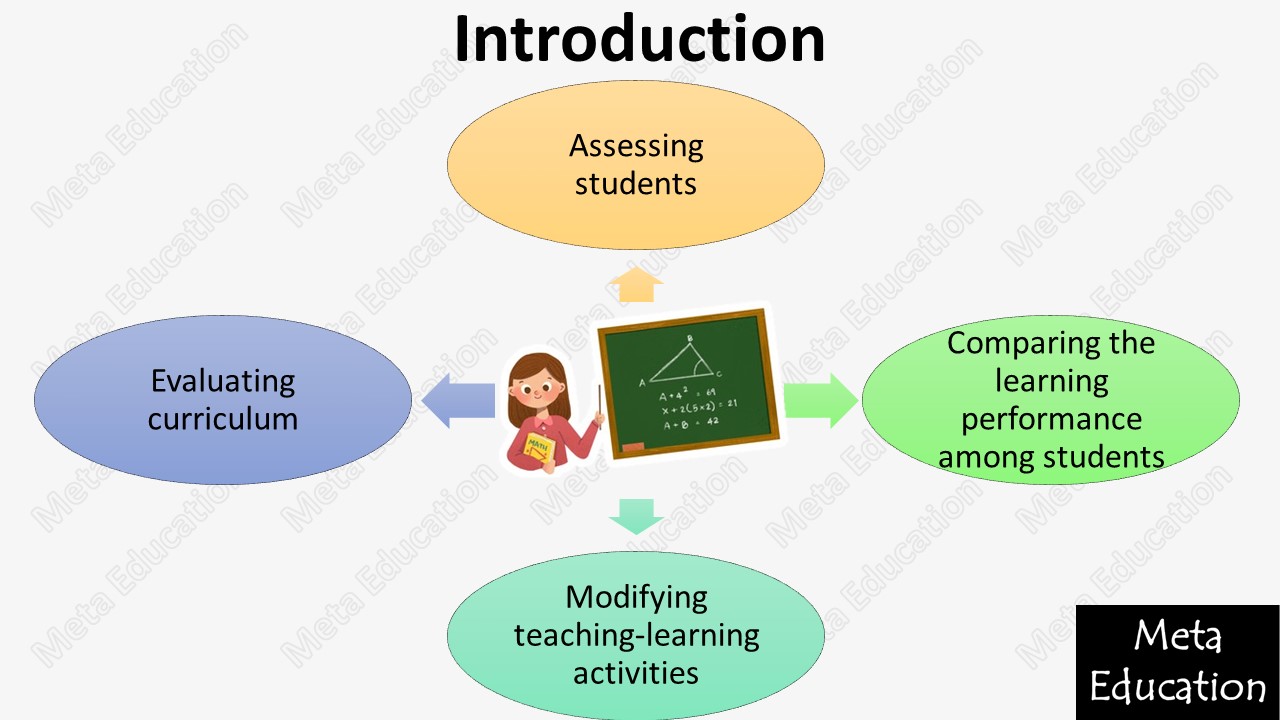
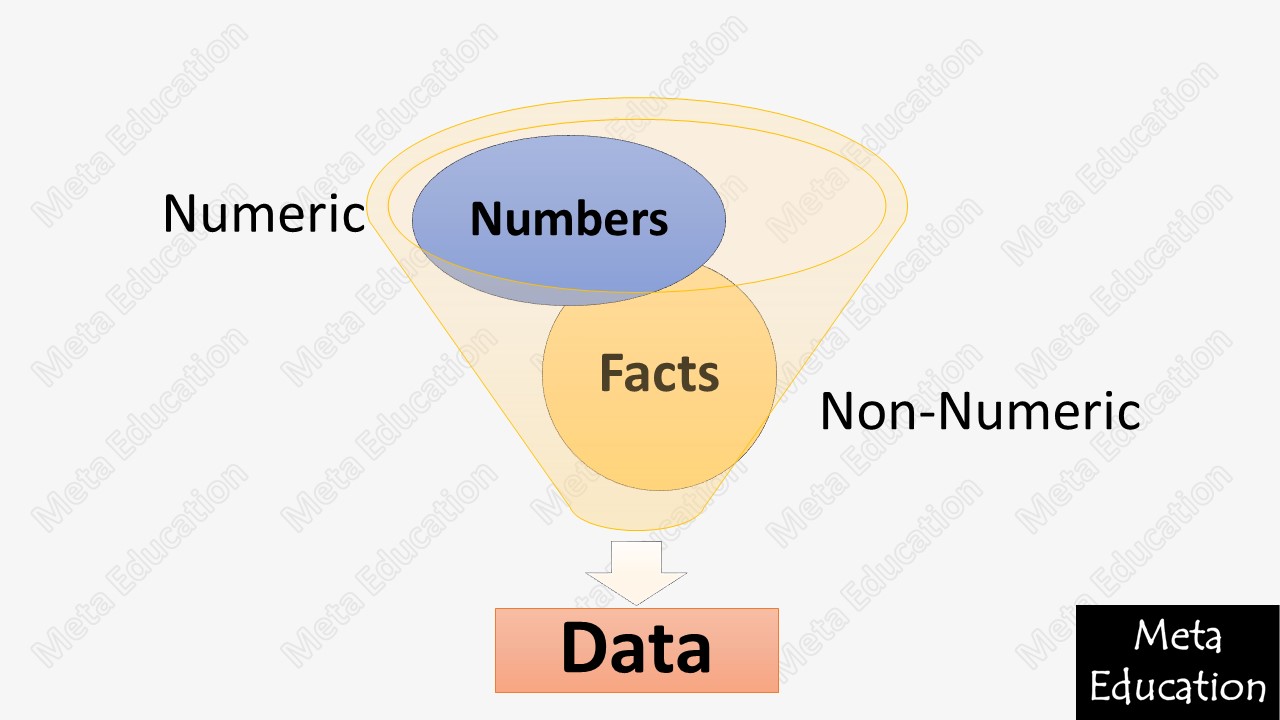
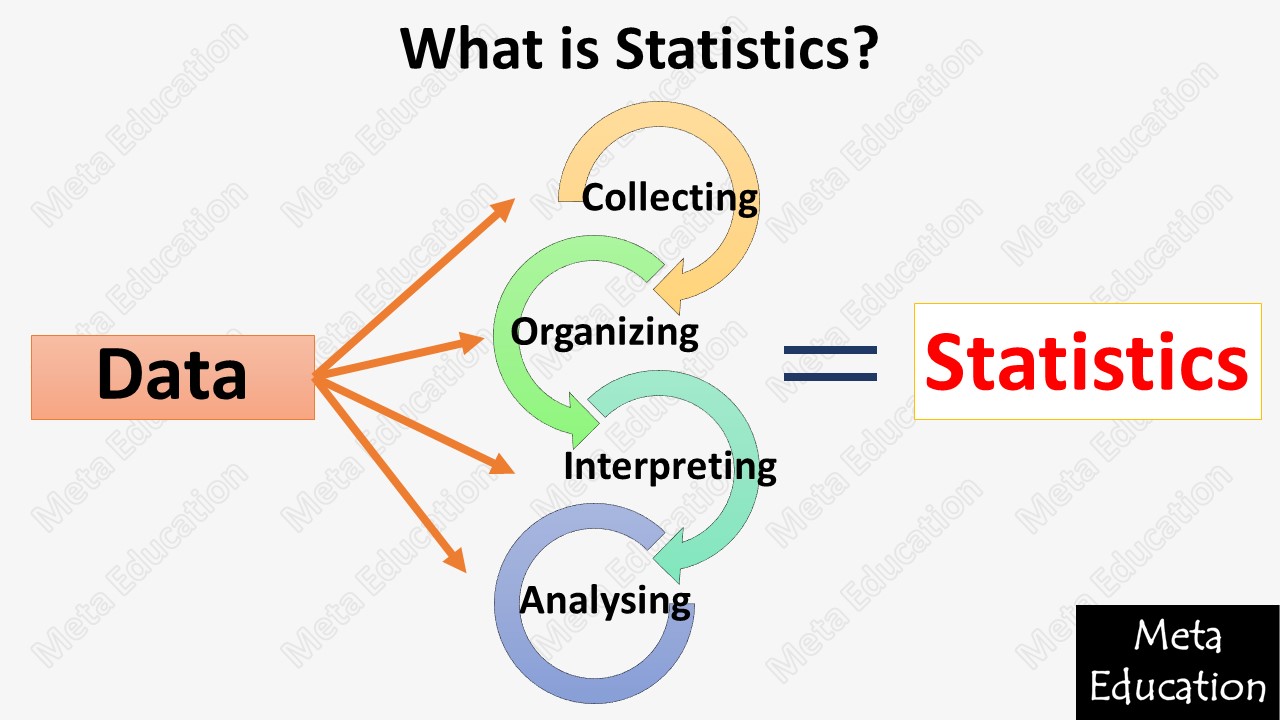

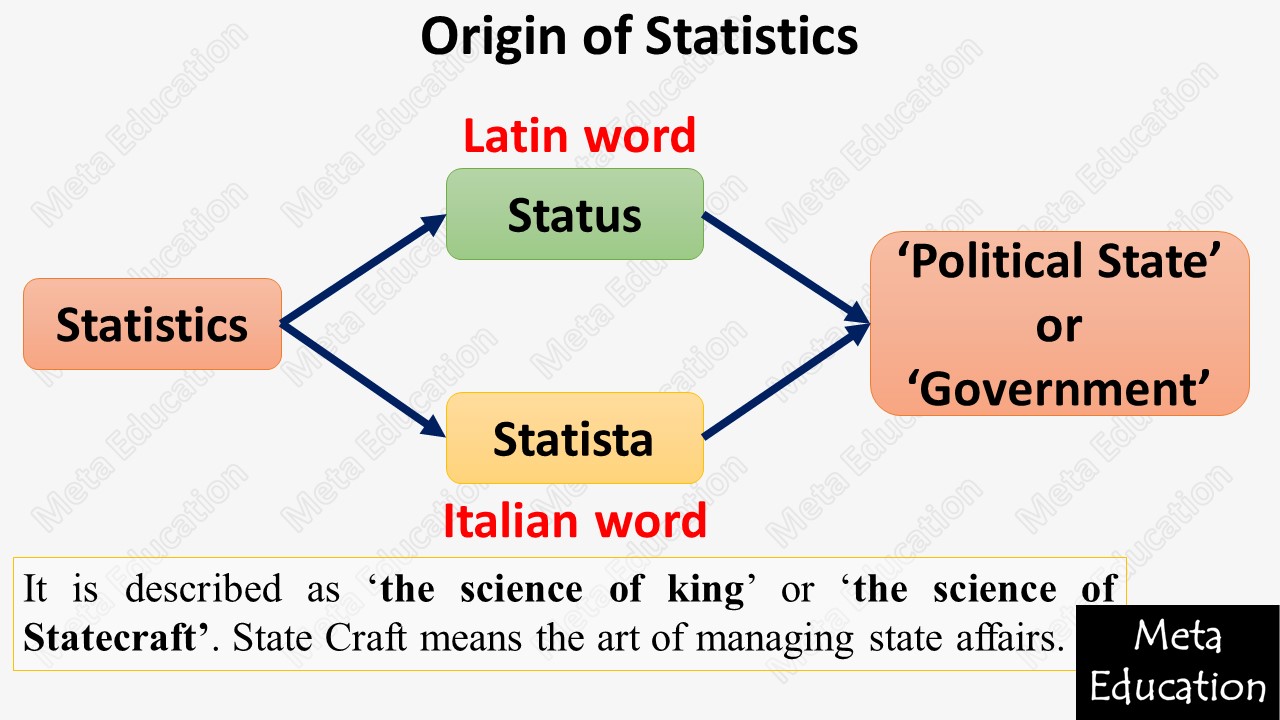
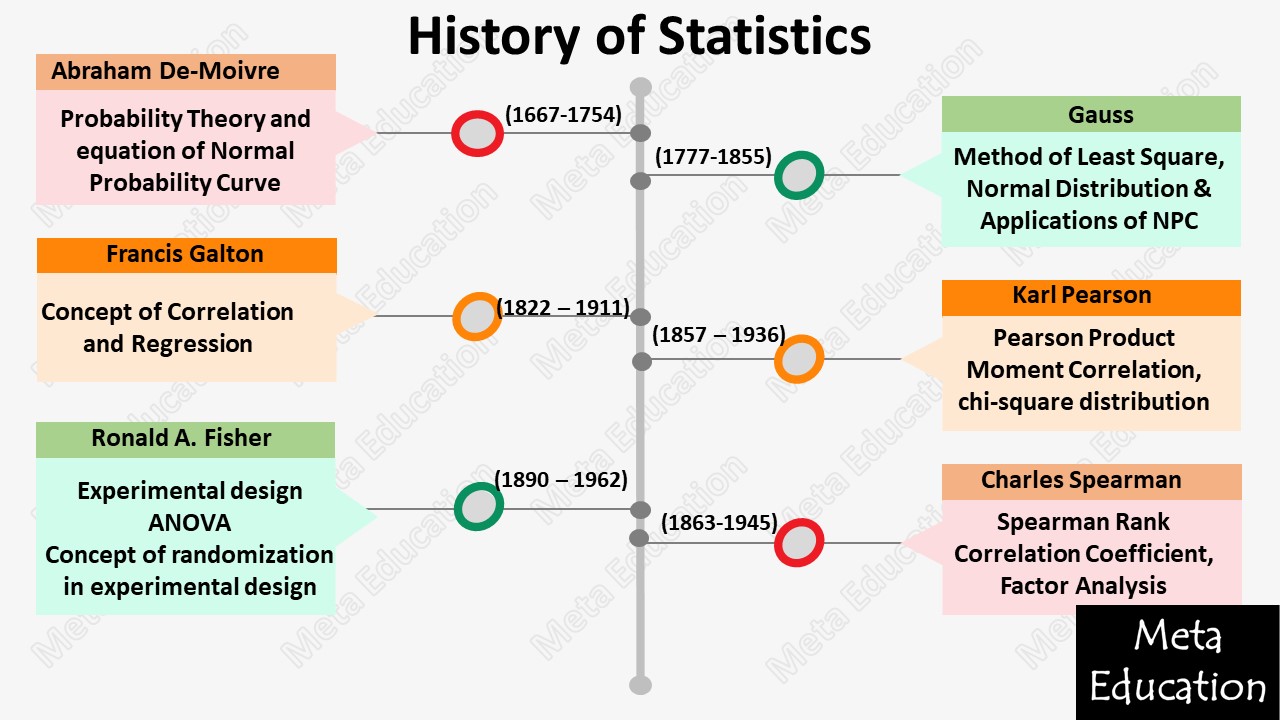
Hindi Audio transcript
Hello, this is Shalini.
Today we will learn about concept origin and history of statistics.
This is the lesson one of unit (a) of statistics applicable in assessment for learning.
After completing this lesson, you will be able to explain the concept of statistics,
summarize the concept and history of statistics, explain the meaning of statistics,
recognize the work done by statisticians, and appreciate the contribution of statisticians.
Concept of statistics.
In day to day life or teacher has to deal with many kinds of data,
in assessing students, in comparing the learning performance among the students,
in modifying teaching learning activities, and in evaluating curriculum,
a teacher has to go through with different kinds of data.
To carry out all these activities, varied types of data need to be collected,
generally, we collect data in two forms or we can say we collect information in two forms,
one is numeric and second is non numeric that is facts.
So, this is not data, this is just information, but when we process this information, this become data. Now see, what is statistics.
So, the process of collecting organizing, analyzing and interpreting data is known as statistics.
Whenever we process any type of data, whenever we collect any type of data,
whenever we analyzed any type of data or we interpreted it in any form, it is known as statistics.
Now see, what is the origin of statistics?
It is originated from two fields one is game of chance, and second political field,
game of chance is concerned with the concept of chance or probability,
this field is basically related to the gamblers So, we can say that statistics is originated from the gamblers
and the other fields that is political field is concerned with collection of state related data,
in political field or in in political area, the stakeholders of politics has to deal with many kinds of data
or they have to collect different kinds of data, they have to do some analysis on the data.
So, they get some meaningful conclusion out of that.
So, in that sense, we can say that statistics is originated from political field.
So, there are main two fields first is game of chance and second is political field.
If we talk about the word statistics, statistics word is originated from a Latin word
that is a status some says it originated from Italian word that is a statista
both have the same meaning, that is political state or government.
some other thoughts are also present regarding the origin of a statistics word
one is, it is originated from German word that is a statistik and
another thought regarding origin is, it is originated from a French word that is statistique
here the pronunciation is quite similar, but the spelling is different.
The meaning of both is state so in conclusion, we can say that all four words either Latin, Italian, German, or French has different origin word but the meaning is same.
According to john Grant (1622-1674), the word statistic is originated from Italian word status.
And another Italian word is stato.
here the meaning is quite different from the previous ones status and status is known as a person who deals with affairs of the state
he or she can be a king or monarch or government.
So in this sense, statistics is described as the science of King or the science of statecraft.
Here the meaning of statecraft is the art of managing state of affairs, how a king or monarch or government is efficient in managing state of affairs
impacts their power to deal with different kinds of problems and affairs related to state I hope the origin of statistics is clear to you now.
Now, lets see, prominent statisticians and their contribution in the field of statistics.
So, first is Abraham De-Moreover, he has given the theory of probability an equation of normal probability curve that is called NPC.His time period is 1667 to 1754.
After him, another statistical is Gauss (1777 to 1855). He gave the method of least square, normal distribution and application of NPC.
Next is Francis Galton (1822 to 1911). He gave the concept of correlation And Regressionthese are very meaningful and helpful concepts in the field of statistics.
1857 to 1936, Karl Pearson, he gave the concept of Pearson product moment correlation and chi square distribution.
Next is Charles Spearsman 1863 to 1945 he gave the concept of Spearsmen rank correlation coefficient and factor analysis.
Next is 1890 to 1962 Ronald A. Fisher, he gave the concept of experimental design, ANOVA, concept of randomization in experimental design.
I hope now you get short introduction about statistics and some information about statisticians and their contributions.
If you have any kind of doubt, you can ask us by comment in the comment box.
Thank you and have a nice day.
1.1 सांख्यिकी
की अवधारणा
दिन-प्रतिदिन
के जीवन में,
एक
शिक्षक
विभिन्न
प्रकार के
प्रदतों के
साथ कार्य
करते है।
छात्रों के
आकलन के अलावा,
प्रदत
कई उद्देश्यों
की पूर्ति
करते है जैसे
कि छात्रों के
बीच सीखने के
प्रदर्शन की
तुलना करना,
शिक्षण-अधिगम
गतिविधियों
को संशोधित
करना, पाठ्यक्रम
का मूल्यांकन
करना, आदि
। इन
गतिविधियों
को करने के
लिए, विभिन्न
प्रकार के
प्रदत एकत्र
करने की आवश्यकता
होती है। आम
तौर पर, प्रदतों
को
संख्यात्मक
अथवा
गुणात्मक रूप
में एकत्र किया
जाता है। इस
प्रक्रिया
में, प्रदत
पहले एकत्र
किए जाते हैं
और फिर निर्णय
लेने के लिए
उनकी
व्याख्या की
जाती है।
प्रदत एकत्र
करने, व्यवस्थित
करने, व्याख्या
करने और
विश्लेषण
करने की
प्रक्रिया को
"सांख्यिकी"
कहा जाता है।
मूल प्रदत को
कुछ
अर्थपूर्ण
जानकारी में
परिवर्तित
करने के लिए,
हमें
सांख्यिकी का
प्रयोग करने
की आवश्यकता होती
है।
सांख्यिकी
हमें
उद्देश्यपूर्ण
तरीके से मूल प्रदतों
का अध्ययन
करने में
सक्षम बनाती
है। यह
शिक्षण-अधिगम
प्रक्रिया को
अधिक कुशल बनाती
है।
इस पाठ
में हम
सांख्यिकी,
इसकी
अवधारणा, प्रकृति
और कैसे एक
शिक्षक प्रदत
का विश्लेषण
करने और
निष्कर्ष
निकालने के
लिए विभिन्न सांख्यिकीय
तकनीकों का
उपयोग कर सकते
हैं, के
बारे में
समझेंगे ।
1.2 सांख्यिकी
की उत्पत्ति
सांख्यिकी
एक नया अध्ययन
का विषय नहीं
है, बल्कि
यह मानव समाज
के समान ही
प्राचीन है,क्योंकि
एक मनुष्य
द्वारा लिए गए
अधिकांश निर्णय
अतीत के
अनुभवों पर
आधारित होते
हैं, जिन्हें
उसने वास्तव
में अनुभव
किया है, जो
प्रत्यक्ष या
अप्रत्यक्ष
रूप से
सांख्यिकीय
प्रदतों पर
आधारित होते
हैं और भविष्य
की घटनाओं का
अनुमान उस
विशेष घटना के
पिछले
व्यवहार का
उपयोग या
अनुसंधान
करके भी लगाया
जाता है।
सांख्यिकी दो
अलग-अलग
क्षेत्रों से
उत्पन्न हुई
है। वह हैं games
of chance और
राजनीतिक
क्षेत्र ।
इनमें से
पूर्व अर्थात games
of chance का
संबंध अवसर और
संभावनाओं की
अवधारणा से है
जबकि
उत्तरार्द्ध
अर्थात
राजनीतिक
क्षेत्र
सांख्यिकी के
संग्रह से
संबंधित माना
जाता है ।
ऐसा
माना जाता है
कि 'सांख्यिकी'
शब्द
लैटिन शब्द 'स्टेटस'
या
इटेलिअन शब्द 'स्टेटिस्टा'
से
लिया गया है,
जिसका
अर्थ है 'राजनीतिक
राज्य' या
'सरकार'।
कुछ अन्य
मान्यताएँ
हैं कि 'सांख्यिकी'
शब्द
जर्मन शब्द 'स्टेटिस्टिक'
या
फ्रेंच शब्द 'स्टेटिस्टिक'
से
लिया गया है
जिसका अर्थ है
'राज्य'।
सांख्यिकी
शब्द की
उत्पत्ति के
बारे में कुछ
अन्य मत भी
उपलब्ध हैं।
जॉन ग्रंट (1620-1674)
के
अनुसार, 'सांख्यिकी'
शब्द
इटेलिअन मूल
का है और यह 'स्टेटो'
व
‘स्टेटिस्टा’
शब्द
से बना है
जिसका का अर्थ
है एक व्यक्ति
जो राज्य के
मामलों से
संबंधित होता
है, अर्थात
राजा, सम्राट
या सरकारें ।
इसलिए
सांख्यिकी को ‘राजा
का विज्ञान’
या
'शासन
कला
(स्टेटक्राफ्ट)
का विज्ञान'
के
रूप में
वर्णित किया
गया है। 'शासन
कला का अर्थ
राज्य मामलों
के प्रबंधन की
कला से है।
दूसरे रूप में,
सांख्यिकी
को
अनुप्रयुक्त
गणित (Applied Mathematics)
की एक शाखा भी
कहा जाता है।
सांख्यिकीय
विधियों का
वर्तमान
स्वरूप
प्रायिकता
(संभाव्यता)
के सिद्धांत
पर आधारित है
जो दुनिया के
इतिहास में एक
बड़ा कदम
साबित हुआ है।
1.3 सांख्यिकी
का इतिहास
सत्रहवीं
शताब्दी के
मध्य में
सांख्यिकी के सैद्धांतिक
विकास का मूल
समय माना जाता
है । समान्यतः
सांख्यिकी
विषय के विकास
का श्रेय फ्रांस,
जर्मनी
और इंग्लैंड
के गणितज्ञों
और जुआरियों
को जाता है।
डी-मोइवर (1667-1754),
गॉस
(1777-1855), ने
संभाव्यता
सिद्धांत और
कम से कम वर्ग
की विधि दी,
फ्रांसिस
गालटन (1822 - 1911), कार्ल
पियर्सन (1857
- 1936), रोनाल्ड
ए. फिशर (1890
- 1962) आदि,
विभिन्न
क्षेत्रों के
प्रमुख
लेखकों में से
हैं जिनका
सांख्यिकी
विषय में
महत्वपूर्ण योगदान
है। 18 वीं
शताब्दी के
दौरान, अंग्रेजी
लेखकों ने
अपने कार्यों
में सांख्यिकी
शब्द का उपयोग
किया था ।
पिछली कुछ
शताब्दियों
के दौरान
सांख्यिकी
धीरे-धीरे
विकसित हुई है
। उन्नीसवीं
शताब्दी के
अंत में बहुत
काम किया गया
था। 20 वीं
शताब्दी की
शुरुआत में,
विलियम
एस गोसेट (1876-1937)
ने
प्रदत के छोटे
सेटों के आधार
पर निर्णय लेने
के तरीकों को
विकसित किया।
निम्नलिखित
तालिका
सांख्यिकी के
क्षेत्र में
कुछ सांख्यिकीविदों
/ गणितज्ञों / वैज्ञानिकों
के योगदान को
दर्शाती है:
|
सांख्यिकीविद
/ गणितज्ञ /
वैज्ञानिक |
योगदान |
|
अब्राहम
डे-मोइवर (1667-1754) और
अन्य |
प्रायिकता
सिद्धांत और
सामान्य
प्रायिकता वक्र
का समीकरण |
|
गॉस (1777-1855) |
लिस्ट
स्क्वायर की
विधि, प्रसामान्य
वितरण, प्रसामान्य
प्रायिकता
वक्र के
अनुप्रयोग
(गॉसस वक्र) |
|
फ्रांसिस
गाल्टन (1822 - 1911) |
सहसंबंध
और
प्रतिपगमन
की अवधारणा |
|
कार्ल
पियर्सन (1857 - 1936) |
पियर्सन
उत्पाद
गुणनफल
आघूर्ण
सहसंबंध, काई
- वर्ग वितरण |
|
चार्ल्स
स्पीयरमैन (1863-1945) |
स्पीयरमैन
श्रेणीक्रम
सहसंबंध
गुणांक, कारक
विश्लेषण |
|
विलियम
एस गोसेट (1876-1937) |
स्टूडेंट्स
टी-वितरण, सांख्यिकीय
सार्थकता |
|
रोनाल्ड
ए. फिशर (1890 - 1962) |
प्रायोगिक
आलेख, सांख्यिकीय
निष्कर्ष, प्रसरण
विश्लेषण (ANOVA),
प्रयोगात्मक
आलेखों में
यादृच्छिककरण
की अवधारणा |
इन सभी
वैज्ञानिकों
के योगदान ने
सांख्यिकी के विकास
में
महत्वपूर्ण
प्रगति दी है।
20 वीं शताब्दी
के दौरान, कई
सांख्यिकीविद्
नए तरीकों,
सिद्धांतों
और सांख्यिकी
के
अनुप्रयोगों
को विकसित
करने में
सक्रिय रहे ।
इन दिनों, सांख्यिकी
की आधुनिक
विकास में
इलेक्ट्रॉनिक्स
की उपलब्धता
निश्चित रूप
से एक प्रमुख
कारक है। एक
अध्यन
क्षेत्र के
रूप में
सांख्यिकी दिन-ब-दिन
विकसित हो रही
है ।
Lesson 1. Concept, Origin and History of Statistics
Learning Objectives:
After completing this lesson, you will be able to:
- explain the concept of statistics.
- summarize the concept and history of statistics.
- explain the meaning of statistics.
- recognize the work done by statisticians.
- appreciate the contribution of statisticians.
1.1 Concept of Statistics
In day-to-day life, a teacher deals with different kinds of data. Apart from assessing the students, data serve many purposes such as comparing the learning performance among students, modifying teaching-learning activities, evaluating curriculum, and so on. To carry out these activities, varied types of data need to be collected. Generally, data are collected in the form of numbers or non-numeric forms. In this process, data are first obtained and then interpreted to make decisions. The process of collecting, organizing, interpreting, and analyzing the data is termed “statistics”. For converting raw data into some meaningful information, we need to apply Statistics. Statistics enables us to study raw scores objectively. It makes the teaching-learning process more efficient.
1.2 Origin of Statistics
Statistics is not a new discipline but it is as old as human society itself. This is because most of the decisions taken by a human being are based on past experiences he/she has experienced actually, which are directly or indirectly based on statistical data and future events are also predicted by using or examining the past behaviour of that particular event. Statistics has originated from two different fields. They are games of chance and political fields. You may note that the former i.e. games of chance is concerned with the concept of chance and probabilities while the latter (i.e. political fields) with the collection of data.
It is believed that the word ‘statistics’ is derived from the Latin word ‘Status’ or from the Italian word ‘Statista’ both meaning a ‘Political State’ or ‘Government’. Some other beliefs are that the word ‘Statistics’ is derived from the German word ‘Statistik’ or from the French word ‘Statistique’ which means ‘State’. Some other opinions are also available about the origin of the word Statistics. According to John Graunt (1620-1674), the word ‘Statistics’ is of Italian origin and it is derived from the word ‘Stato’ and ‘statista’, which means a person who deals with affairs of the state. That is, initially kings or monarchs or governments. That is why it’s described as ‘the science of king’ or ‘the science of Statecraft’. State Craft means the art of managing state affairs. In another form, statistics is said to be a branch of applied mathematics. The present form of statistical methods is based on the theory of probability, which marked a major step in the history of the world.
1.3 History of Statistics
The theoretical development of statistics had its origin in the mid-seventeenth century. Generally, mathematicians and gamblers of France, Germany, and England are credited for the development of the subject statistics. De-Moivre (1667-1754), Gauss (1777-1855), Francis Galton (1822 – 1911), Karl Pearson (1857 – 1936), Ronald A. Fisher (1890 – 1962), etc. are among the prominent authors from different fields whose contribution to the subject statistics is well recognized. During the 18th century, English writers used the word statistics in their works. statistics has developed gradually during the last few centuries. A lot of work was done at the end of the nineteenth century. At the beginning of the 20th century, William S Gosset (1876-1937) developed the methods for decision-making based on small sets of data.
The following table shows the contribution of some statisticians/mathematician/scientists in the field of statistics:
Statistics/mathematicians/Scientists | Their Contributions |
Abraham De-Moivre (1667-1754) & others | Probability Theory and equation of Normal Probability Curve |
Gauss (1777-1855) | Method of Least Square, Normal Distribution, Applications of Normal Probability Curve (Gaussian Curve) |
Francis Galton (1822 – 1911) | Concept of Correlation and Regression |
Karl Pearson (1857 – 1936) | Pearson Product Moment Correlation, chi-square distribution |
Charles Spearman (1863-1945) | Spearman Rank Correlation Coefficient, Factor Analysis |
William S Gosset (1876-1937) | Student’s t-distribution, Statistical significance |
Ronald A. Fisher (1890 – 1962) | Experimental design, statistical inference, Analysis of Variance (ANOVA). Concept of randomization in experimental design |
Contributions of all these scientists have made significant advances in the development of statistics. During the 20th century, several statisticians were active in developing new methods, theories, and applications of statistics. These days, the availability of electronics is certainly a major factor in the modern development of statistics. As a discipline statistic is developing day by day.
पाठ 1. सांख्यिकी की अवधारणा, उत्पत्ति व इतिहास
अधिगम उद्देश्य:
इस पाठ को पूरा करने के बाद, आप:
- सांख्यिकी की अवधारणा को समझा सकेंगे ।
- सांख्यिकी की अवधारणा और इतिहास को संक्षेप में प्रस्तुत कर सकेंगे ।
- सांख्यिकी का अर्थ समझा सकेंगे
- सांख्यिकीविदों द्वारा किए गए कार्यों का प्रत्यास्मरण कर सकेंगे ।
- सांख्यिकीविदों द्वारा किए गए कार्यों की सराहना कर सकेंगे ।
1.1 सांख्यिकी की अवधारणा
दिन-प्रतिदिन के जीवन में, एक शिक्षक विभिन्न प्रकार के प्रदतों के साथ कार्य करते है। छात्रों के आकलन के अलावा, प्रदत कई उद्देश्यों की पूर्ति करते है जैसे कि छात्रों के बीच सीखने के प्रदर्शन की तुलना करना, शिक्षण-अधिगम गतिविधियों को संशोधित करना, पाठ्यक्रम का मूल्यांकन करना, आदि । इन गतिविधियों को करने के लिए, विभिन्न प्रकार के प्रदत एकत्र करने की आवश्यकता होती है। आम तौर पर, प्रदतों को संख्यात्मक अथवा गुणात्मक रूप में एकत्र किया जाता है। इस प्रक्रिया में, प्रदत पहले एकत्र किए जाते हैं और फिर निर्णय लेने के लिए उनकी व्याख्या की जाती है। प्रदत एकत्र करने, व्यवस्थित करने, व्याख्या करने और विश्लेषण करने की प्रक्रिया को “सांख्यिकी” कहा जाता है। मूल प्रदत को कुछ अर्थपूर्ण जानकारी में परिवर्तित करने के लिए, हमें सांख्यिकी का प्रयोग करने की आवश्यकता होती है। सांख्यिकी हमें उद्देश्यपूर्ण तरीके से मूल प्रदतों का अध्ययन करने में सक्षम बनाती है। यह शिक्षण-अधिगम प्रक्रिया को अधिक कुशल बनाती है।
इस पाठ में हम सांख्यिकी, इसकी अवधारणा, प्रकृति और कैसे एक शिक्षक प्रदत का विश्लेषण करने और निष्कर्ष निकालने के लिए विभिन्न सांख्यिकीय तकनीकों का उपयोग कर सकते हैं, के बारे में समझेंगे ।
1.2 सांख्यिकी की उत्पत्ति
सांख्यिकी एक नया अध्ययन का विषय नहीं है, बल्कि यह मानव समाज के समान ही प्राचीन है,क्योंकि एक मनुष्य द्वारा लिए गए अधिकांश निर्णय अतीत के अनुभवों पर आधारित होते हैं, जिन्हें उसने वास्तव में अनुभव किया है, जो प्रत्यक्ष या अप्रत्यक्ष रूप से सांख्यिकीय प्रदतों पर आधारित होते हैं और भविष्य की घटनाओं का अनुमान उस विशेष घटना के पिछले व्यवहार का उपयोग या अनुसंधान करके भी लगाया जाता है। सांख्यिकी दो अलग-अलग क्षेत्रों से उत्पन्न हुई है। वह हैं games of chance और राजनीतिक क्षेत्र । इनमें से पूर्व अर्थात games of chance का संबंध अवसर और संभावनाओं की अवधारणा से है जबकि उत्तरार्द्ध अर्थात राजनीतिक क्षेत्र सांख्यिकी के संग्रह से संबंधित माना जाता है ।
ऐसा माना जाता है कि ‘सांख्यिकी’ शब्द लैटिन शब्द ‘स्टेटस‘ या इटेलिअन शब्द ‘स्टेटिस्टा‘ से लिया गया है, जिसका अर्थ है ‘राजनीतिक राज्य’ या ‘सरकार’। कुछ अन्य मान्यताएँ हैं कि ‘सांख्यिकी’ शब्द जर्मन शब्द ‘स्टेटिस्टिक‘ या फ्रेंच शब्द ‘स्टेटिस्टिक‘ से लिया गया है जिसका अर्थ है ‘राज्य’। सांख्यिकी शब्द की उत्पत्ति के बारे में कुछ अन्य मत भी उपलब्ध हैं। जॉन ग्रंट (1620-1674) के अनुसार, ‘सांख्यिकी’ शब्द इटेलिअन मूल का है और यह ‘स्टेटो‘ व ‘स्टेटिस्टा’ शब्द से बना है जिसका का अर्थ है एक व्यक्ति जो राज्य के मामलों से संबंधित होता है, अर्थात राजा, सम्राट या सरकारें । इसलिए सांख्यिकी को ‘राजा का विज्ञान’ या ‘शासन कला (स्टेटक्राफ्ट) का विज्ञान’ के रूप में वर्णित किया गया है। ‘शासन कला का अर्थ राज्य मामलों के प्रबंधन की कला से है। दूसरे रूप में, सांख्यिकी को अनुप्रयुक्त गणित (Applied Mathematics) की एक शाखा भी कहा जाता है। सांख्यिकीय विधियों का वर्तमान स्वरूप प्रायिकता (संभाव्यता) के सिद्धांत पर आधारित है जो दुनिया के इतिहास में एक बड़ा कदम साबित हुआ है।
1.3 सांख्यिकी का इतिहास
सत्रहवीं शताब्दी के मध्य में सांख्यिकी के सैद्धांतिक विकास का मूल समय माना जाता है । समान्यतः सांख्यिकी विषय के विकास का श्रेय फ्रांस, जर्मनी और इंग्लैंड के गणितज्ञों और जुआरियों को जाता है। डी-मोइवर (1667-1754), गॉस (1777-1855), ने संभाव्यता सिद्धांत और कम से कम वर्ग की विधि दी, फ्रांसिस गालटन (1822 – 1911), कार्ल पियर्सन (1857 – 1936), रोनाल्ड ए. फिशर (1890 – 1962) आदि, विभिन्न क्षेत्रों के प्रमुख लेखकों में से हैं जिनका सांख्यिकी विषय में महत्वपूर्ण योगदान है। 18 वीं शताब्दी के दौरान, अंग्रेजी लेखकों ने अपने कार्यों में सांख्यिकी शब्द का उपयोग किया था । पिछली कुछ शताब्दियों के दौरान सांख्यिकी धीरे-धीरे विकसित हुई है । उन्नीसवीं शताब्दी के अंत में बहुत काम किया गया था। 20 वीं शताब्दी की शुरुआत में, विलियम एस गोसेट (1876-1937) ने प्रदत के छोटे सेटों के आधार पर निर्णय लेने के तरीकों को विकसित किया।
निम्नलिखित तालिका सांख्यिकी के क्षेत्र में कुछ सांख्यिकीविदों / गणितज्ञों / वैज्ञानिकों के योगदान को दर्शाती है:
|
सांख्यिकीविद / गणितज्ञ / वैज्ञानिक |
योगदान |
|
अब्राहम डे-मोइवर (1667-1754) और अन्य |
प्रायिकता सिद्धांत और सामान्य प्रायिकता वक्र का समीकरण |
|
गॉस (1777-1855) |
लिस्ट स्क्वायर की विधि, प्रसामान्य वितरण, प्रसामान्य प्रायिकता वक्र के अनुप्रयोग (गॉसस वक्र) |
|
फ्रांसिस गाल्टन (1822 – 1911) |
सहसंबंध और प्रतिपगमन की अवधारणा |
|
कार्ल पियर्सन (1857 – 1936) |
पियर्सन उत्पाद गुणनफल आघूर्ण सहसंबंध, काई – वर्ग वितरण |
|
चार्ल्स स्पीयरमैन (1863-1945) |
स्पीयरमैन श्रेणीक्रम सहसंबंध गुणांक, कारक विश्लेषण |
|
विलियम एस गोसेट (1876-1937) |
स्टूडेंट्स टी-वितरण, सांख्यिकीय सार्थकता |
|
रोनाल्ड ए. फिशर (1890 – 1962) |
प्रायोगिक आलेख, सांख्यिकीय निष्कर्ष, प्रसरण विश्लेषण (ANOVA), प्रयोगात्मक आलेखों में यादृच्छिककरण की अवधारणा |
इन सभी वैज्ञानिकों के योगदान ने सांख्यिकी के विकास में महत्वपूर्ण प्रगति दी है। 20 वीं शताब्दी के दौरान, कई सांख्यिकीविद् नए तरीकों, सिद्धांतों और सांख्यिकी के अनुप्रयोगों को विकसित करने में सक्रिय रहे । इन दिनों, सांख्यिकी की आधुनिक विकास में इलेक्ट्रॉनिक्स की उपलब्धता निश्चित रूप से एक प्रमुख कारक है। एक अध्यन क्षेत्र के रूप में सांख्यिकी दिन-ब-दिन विकसित हो रही है ।
English
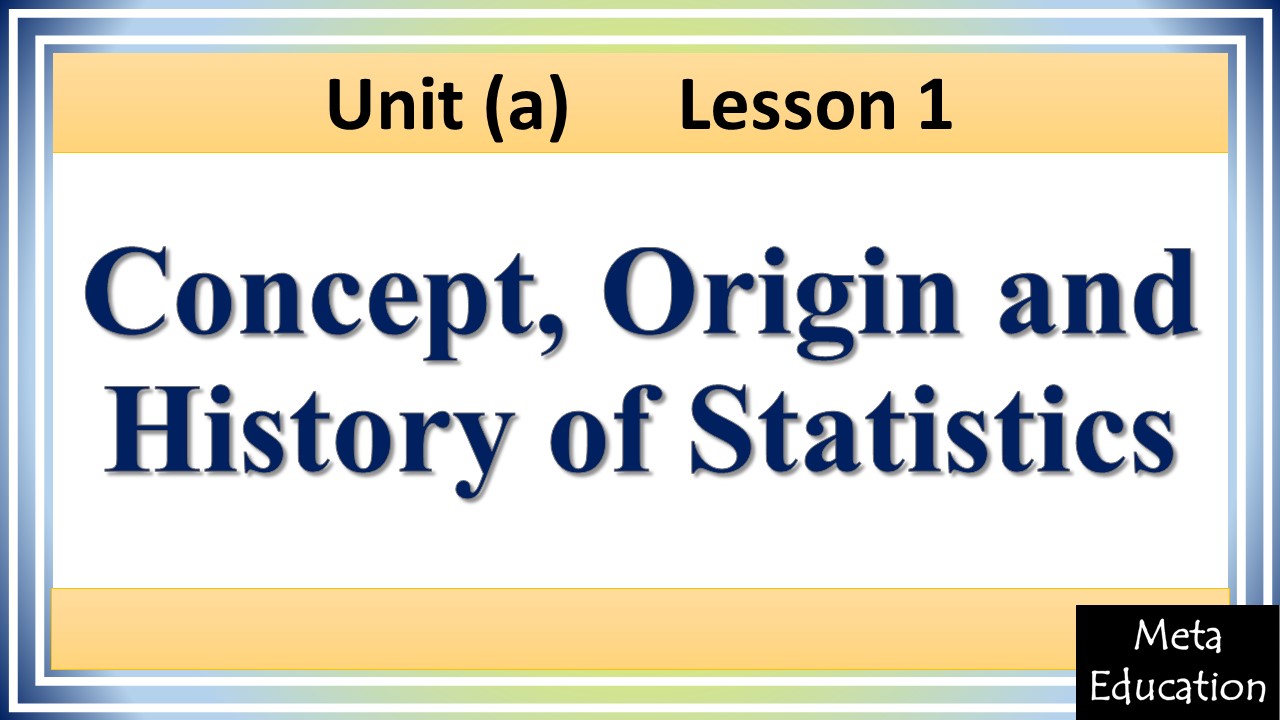 tryy mnblj
tryy mnblj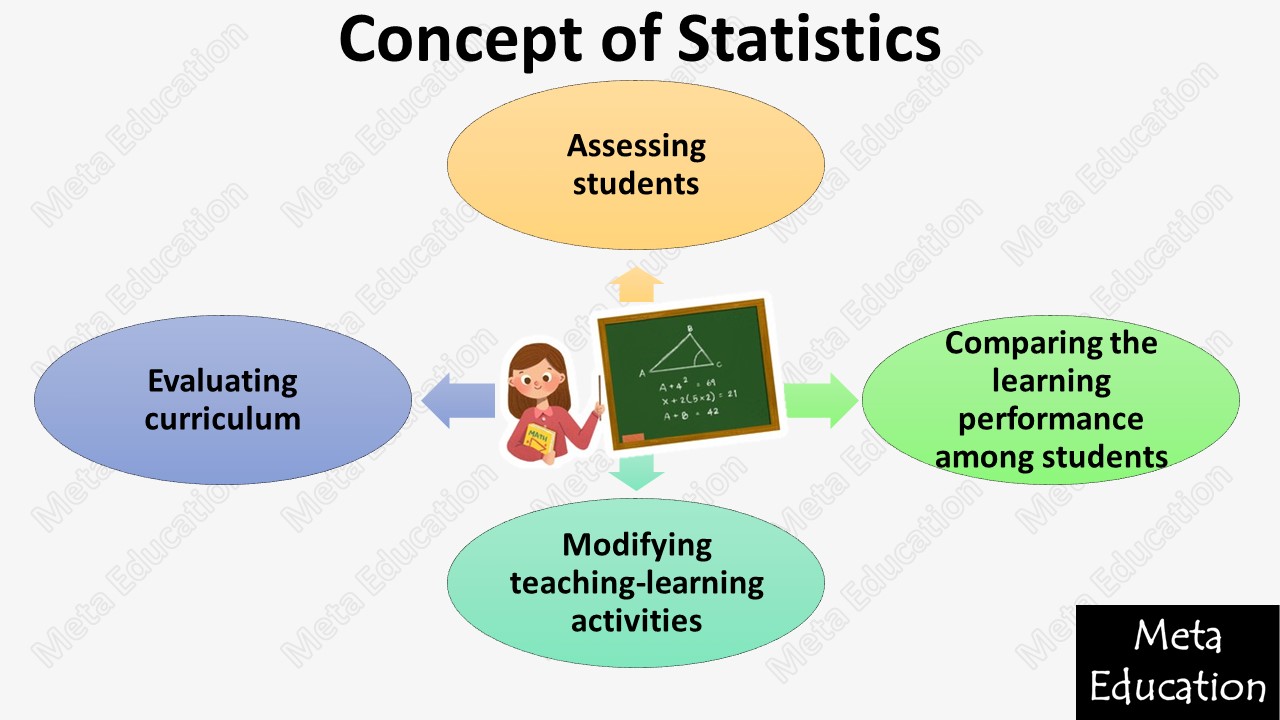
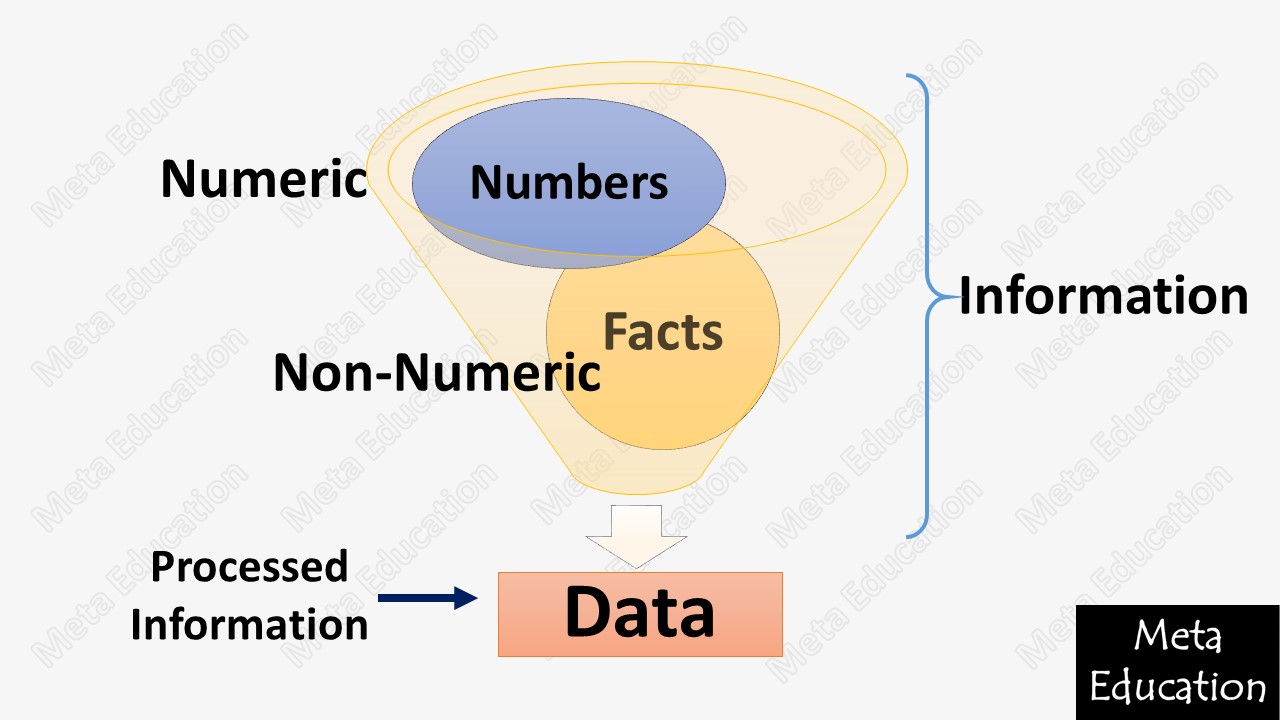
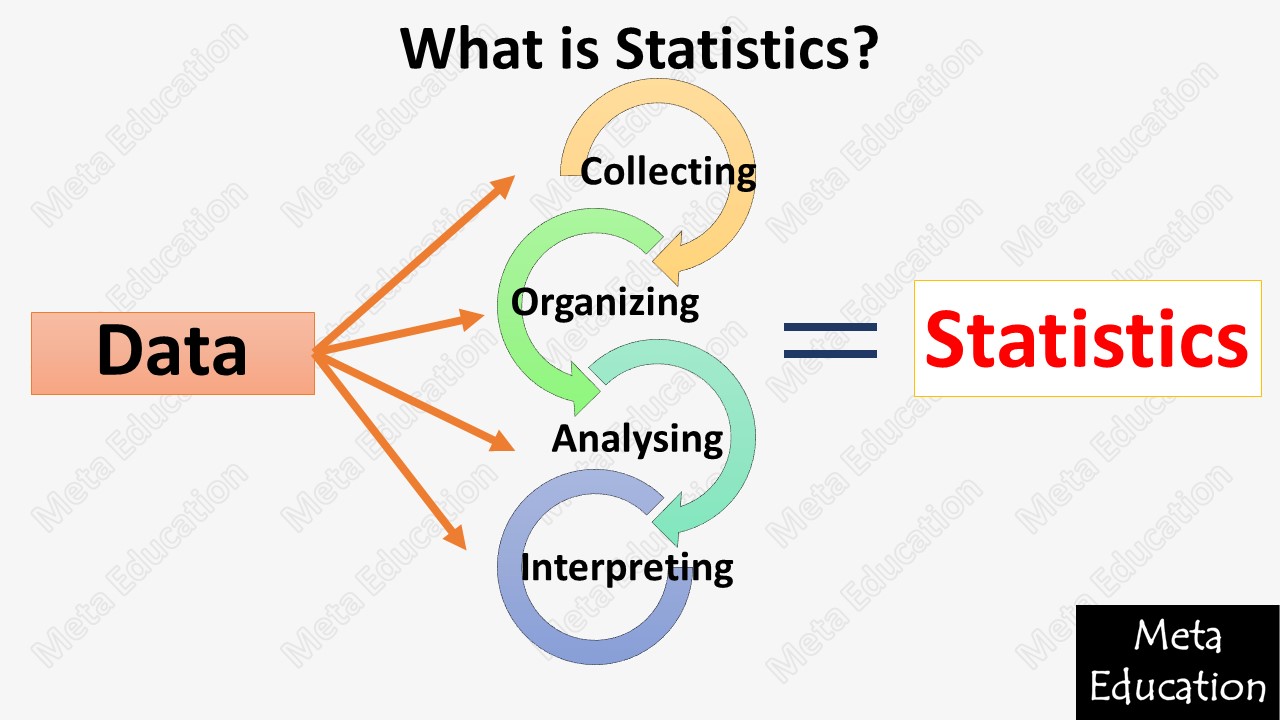

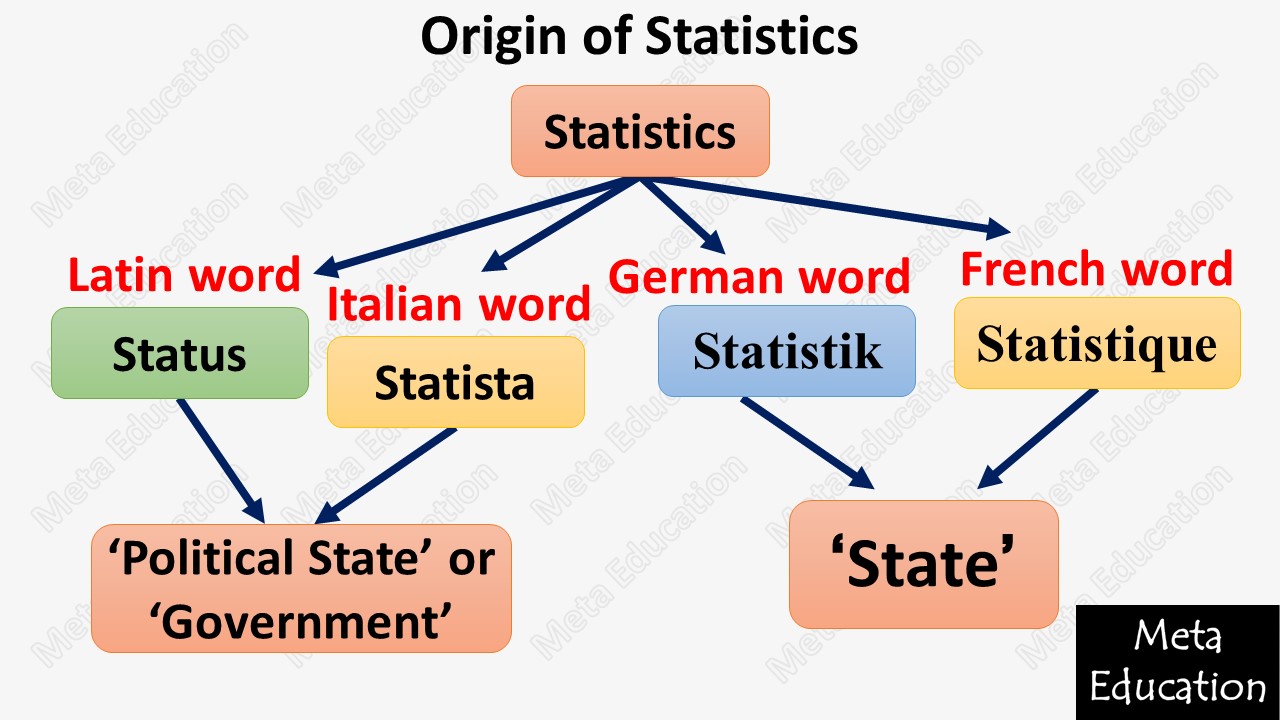


Hindi


